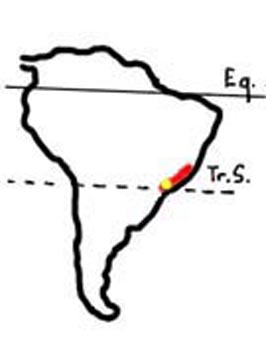*** HISTORY OF SCHLUMBERGERA ORSSICHIANA ***
*** AND ITS HYBRIDS ***
page 1 / 3
INTRODUCTION
When I began my collection of epiphytic cacti, I bought many cuttings from “Rainbow Gardens” in California. In the 1996 catalogue, I noticed a botanical Schlumbergera: “Schlumbergera orssichiana”; the catalogue specified: ” Recent discovery in Brazilian mountains; extra-wide growth, hanging pendant flowers of white with pinkish red edges. Flowers 2”-3” in diameter! Occasionally blooms off season, very rare.”
I immediately ordered a cutting as well as cuttings of several hybrids of this plant because I was fascinated by the unusual shape of the blooms pictured in the catalogue.
At about the same time, I paid a visit to Paul and Mary Hoogvliet, in the Netherlands ; I was interested in their Schlumbergera catalogue. Among others, they suggested I buy “Schlumbergera X “Lysa”, telling me that it was a hybrid of S. orssichiana and that its flower was particularly large and beautiful, of an unusual form. I bought a cutting from them.
The cuttings of S. orssichiana and its hybrids grew without any problem and bloomed a few years later. I was surprised and filled with wonder to see Christmas cacti which had very large flowers and above all whose shape was very different from Christmas cacti flowers that I had seen before.
As growing and blooming didn’t pose any particular problem,
I was more precisely interested in these hybrids, unobtainable from big retailers.
Years later, I discovered another producer who sold them : the EPRIC
foundation in the Netherlands.
Some months ago, Eckhard Meier, a German botanist, forwarded an article to me written by him in German : “Die Schlumbergera orssichiana Story”, published in “Kaktusblüte” published in April 2006, which made me feel like writing this article, falling down into three parts.
A first part reconsiders the history of Christmas cacti ; a second part essentially consists in the translation of E. Meier’s article and deals more particularly with the discovery of S. orssichiana and the propagation of the discovered plants. The last part is a photo gallery of the flowers of S. orssichiana and all its hybrids which bloomed in my collection.
1) BRIEF COME BACK ON HISTORY OF SCHLUMBERGERA
 The
name of the genus Schlumbergera comes from the famous French family Schlumberger,
among whom one member was well-known in the nineteenth century for his Cacti
collection in his castle near Rouen. The genus Schlumbergera includes six
species : S. kauskyi, S. microspherica, S. opuntioides (featured in the Botanical
garden of Rio since 1918), S. russelliana (discovered in 1837), S. truncata
(described in 1819) and finally S. orssichiana discovered only
in the 1970s.
The
name of the genus Schlumbergera comes from the famous French family Schlumberger,
among whom one member was well-known in the nineteenth century for his Cacti
collection in his castle near Rouen. The genus Schlumbergera includes six
species : S. kauskyi, S. microspherica, S. opuntioides (featured in the Botanical
garden of Rio since 1918), S. russelliana (discovered in 1837), S. truncata
(described in 1819) and finally S. orssichiana discovered only
in the 1970s.
All the botanical Schlumbergera (or Zygocactus or Christmas cacti) are epiphytic cacti of the Southern Hemisphere, originating from the red colored zone which includes the yellow block. Only some clones of S. opuntioides and S. x microsphericae are non-epiphytic. It should be noted that the Christmas cacti bloom in May (southern winter) in Brazil.
This red zone is a coastal area of Brazil, approximately 190 miles long, covering the States of Sao Paulo, Rio de Janeiro and Espiritu Santo
Schlumbergera orssichiana is exclusively present near the sea, no far from the Serra da Bocaina, nearly 60 miles west of Rio de Janeiro. This zone is indicated by the yellow block.
Currently, there is approximately a thousand Schlumbergera hybrids listed (roughly 800 in the book “Christmas Cacti” by A.J.S McMillan and J.F.Horobin, published in 1995 and around 1200 in “Schlumbergera: the directory of species and hybrids” by Frank Süpplie, published in 2006 by the EPRIC Foundation).
Due to the time period when the parents were discovered as well as their ease and rapidity in growing, a large majority of the marketed hybrids account for a first group which comes from both the hybridization of S. truncata with S.russelliana and from the cross-breeding of all the preceding hybrids. A very small second group consists in hybrids of S. truncata and S. opuntioides.
Last but not least, two other groups have S. orssichiana as their ancestor : S.X epricae coming from the hybridization of S.russelliana with S. orssichiana and especially nowadays, S.X reginae, which comes from the hybridization of S. orssichiana with S. truncata and from the corresponding hybrids together (The S. x reginae group was described first and the group S. x epricae later). The continuation of this article will be entirely devoted to them and their ancestor S. orssichiana.
PART 2: HISTORY OF SCHLUMBERGERA ORSSICHIANA
PART 3 : THE PHOTO GALLERY OF MY “QUEEN” HYBRIDS
PHOTO GALLERY OF ALL MY CHRISTMAS CACTI FROM 2002 TO 2009
___________________________________________________________________________________